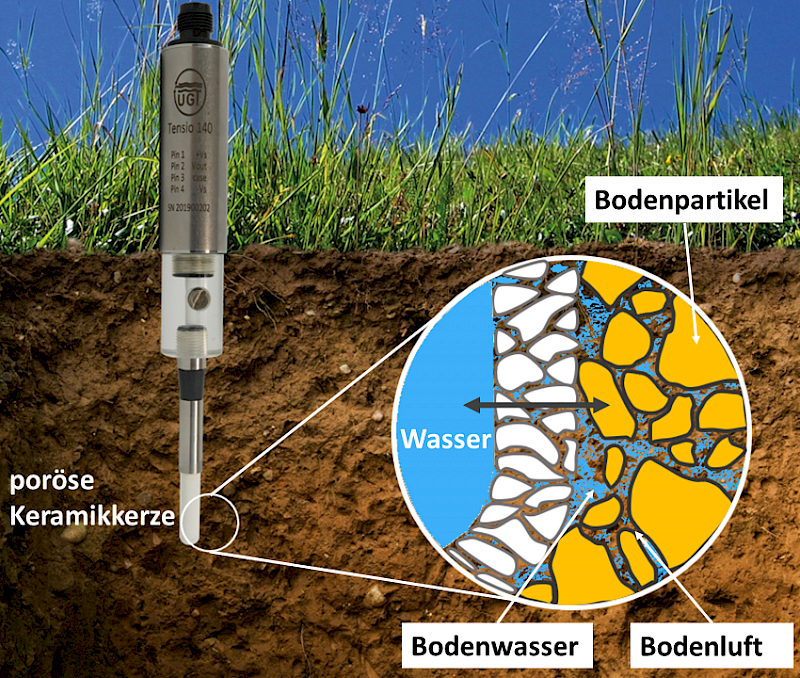Product overview
Tensiometers
The roots of UGT lie in tensiometer technology. Our tensiometers are characterized by the combination of extensive experience and innovative technology. Due to the range of different designs and flexibility in manufacturing, we offer customized solutions. Are you unsure which tensiometer is best suited for your application? Contact us and we will help you find the right solution.
Our products in Tensiometers
Facts about tensiometers
What do I measure with a tensiometer?
Tensiometers are measuring instruments used to determine the pressure under which the soil water is standing. This pressure is called tension or also suction tension or water tension. From the point of view of the potential concept, the tension describes all the effects exerted on the water by the matrix and is accordingly called the matrix potential (outdated also capillary potential).
Tension is closely related to the water content of a soil, i.e. the soil moisture. The drier a soil is, the higher is the Tension. At the groundwater surface, the Tension is zero. The relationship between the water content of the soil and the tension depends on the properties of the soil and is characteristic for each soil.
The tension corresponds to the force which a plant has to apply to deprive water from the soil over the roots. In practice tensiometers are therefore used for irrigation control but also for the evaluation of the influence of the global warming. Further the difference of the tension at two different points within the soil is the driving force for the soil water movement.
Determining this gradient with tensiometers enables to evaluate the movement of the water in the soil regarding flow direction and velocity. Tensiometer measurements are essential for the comprehensive analysis of the water balance of a region or an ecosystem.
A tensiometer consists of an airtight sealed, water-filled measurement volume, a unit for detecting pressure and a porous, water-permeable part. Usually these parts are tensiometer cups made of ceramic. Depending on the scope of work also plastic membranes, sintered plastic or sintered glass may be used. The pores of the porous ceramic cup are filled with water and connect the water of the measurement volume inside the tensiometer with the water in the soil outside the tensiometer.
By connecting the two water bodies the pressure conditions inside the tensiometer are always adjusted to the pressure conditions of the water in the surrounding soil. If the soil dries, water will flow through the pores of the porous tensiometer cup from the measurement volume into the soil, thereby creating a negative pressure inside the tensiometer. The water flow equilibrating the pressures goes on until the negative pressure in the measurement volume corresponds to the negative pressure in the surrounding soil. If the surrounding soil is wetted again, for example by a precipitation event or irrigation, the negative pressure decreases in the surrounding soil and water flows from the soil into the measurement volume, whereby the negative pressure in the measurement volume is reduced again.
A manometer or an electronic pressure transducer measures the pressure inside the measurement volume. Depending on the tensiometer type and design of the tensiometer the pressure is either read manually or captured automatically, whereby the reading unit as well as the storage unit can be integrated in the tensiometer or externally executed. Tensiometers are calibrated so that the measured pressure is zero when the porous tensiometer cup is right at the level of the groundwater surface.
Based on the operating principle the measurement range of conventional, water-filled tensiometers is physically limited. At a negative pressure of approximately 100 kPa the water inside the tensiometer changes into the gaseous phase. Depending on the measurement conditions this point may occur already earlier or be delayed by boiling retardation. From this moment, the pressure change is not longer transferred from the water in the soil. The second physical limit is defined by the air entry point of the ceramic. This point is reached, when the negative pressure is high enough to suck air through the biggest pore of the ceramic. The pore is vented. At this moment the system is not air-tight anymore and the negative pressure suddenly drops. Subsequently the tensions are about zero and it is not possible to build up a negative pressure again.
The upper limit of the measurement range of a tensiometer is defined by whichever point is reached sooner. If this tension is exceeded and the measurement range is left, the tensiometer stops working. This is called “drying up” of the tensiometer. To restore the functionality of the tensiometer it needs to be refilled with water and the tension in the surrounding soil has to be within the measurement range of the tensiometer. Some systems, such as the Full Range Tensiometer of UGT GmbH, are not bound to these limits and cannot fall dry due to innovative operating principles. The ceramics of the UGT tensiometers have by default an air entry point of at least 85 kPa. This value slightly varies for every ceramic and depends next to the maximum pore size also on the state of the ceramic and on substances dissolved in the water. Therefore just a minimum values is stated as upper limit of the measurement range. This value may be exceeded in measurements.
A further prerequisite for the correct function of tensiometers is the correct installation. The porous part has to be in good contact with the soil in order for the pore system of the soil and of the porous part to be connected. Tensiometers should be installed in wet soil if possible. For installation with predrilling, the diameter of the bore hole has to be slightly smaller than the diameter of the porous part. If the porous part is a ceramic, the mechanical force on the ceramic has to be kept as low as possible. Obstacles, such as stones in the soil, can lead to cracks or fractures in the ceramic, so that the system is no longer airtight and therefore no longer functional.
Detailed and Tensiometer-specific information about the installation and maintenance of the tensiometers can be found in the respective operator`s manuals.
Our tensiometers at a glance
| Tensiometer |  |
 |
 |
 |
 |
 |
 |
|---|---|---|---|---|---|---|---|
| Tensio 100 | Tensio 130 | Tensio 140 | Tensio 152 | Tensio 153e | Tensio 160 | Full Range Tensiometer | |
| Type of application | - mobile in the field - for point measurement |
- in the laboratory - for ku-pF apparatus |
- in the laboratory (small lysimeter/laboratory column) | - stationary in the field- frost-protected- for long-term measurement | - stationary in the field - externally fillable - for long term measurement |
- for Lysimeter - for long-term measurement |
- stationary in the field - for long term measurement |
| Mounting position | vertical | horizontal | horizontal/ vertical | horizontal/ vertical | vertikal/ diagonal | horizontal | horizontal/ vertical |
| special notes | - robust and durable - safe transport - fast and accurate measurement |
- Determination of tension and hydraulic conductivity in the laboratory | - precise measurements - minimal disturbance due to small ceramic - especially for laboratory |
- also for demanding applications (highly saline or contaminated soils) - Pressure membrane more durable/ resistant - membrane can freeze without damage |
- also for demanding applications (highly saline or contaminated soils) - Pressure membrane more durable/ resistant - membrane can freeze without damage |
- specially developed for Lysimeter - No removal necessary for new filling |
- Full range tensiometer (measurement over entire nFK) - low energy consumption in measuring mode (20 mA) - with ventilation capillary in cable |
| Pressure acquisition | - Precision vacuum gauge | - electr. pressure transducer | - electr. pressure transducer | - electr. pressure transducer - Signal amplifier |
- electr. pressure transducer - Signal amplifier |
- electr. pressure transducer | - electr. pressure transducer |
| Data transfer | cable | cable | cable | cable | cable | cable | |
| Data acquisition | No storage | Storage in ku-pF apparatus | ext. data logger | ext. data logger | ext. data logger | ext. data logger | ext. data logger (RS485) |
| Data output | manually (read) | Laptop/ PC | Laptop/ PC | Laptop/ PC | Laptop/ PC | Laptop/ PC | Laptop/ PC |
| Measuring range | 0 - 850 hPa | 0 - 850 hPa | 0 - 850 hPa | 0 - 850 hPa | 0 - 850 hPa | 0 - 850 hPa | 0 - 15000 hPa |
| Resolution | 10 hPa | 1 hPa | 1 hPa | 1 hPa | 1 hPa | 1 hPa | 1 hPa |
| Application temperature | 0 - 40 °C | 0 - 40 °C | 0 - 40 °C | 0 - 50 °C | 0 - 50 °C | 0 - 40 °C | 0 - 40 °C |
| Power supply | 5 V/ 1 mA constant | 9 - 30 V (DC)/ <3 mA | 12 - 24 V (DC)/ 0,5 VA | 12 - 24 V (DC)/ 0,5 VA | 12 V (DC)/ 10 mA | 5 - 20 V, 20 mA | |
| Refill | - simple and fast via filling screw | - via filling screw by means of vacuum | - via filling screw by means of vacuum | - via filling screw by means of vacuum | - via external connections | - in installed condition via filling lines - automatic filling optional |
- No filling required |
| Length | 430 mm (for 300 mm standpipe) | 100 mm (with gauge head) | 150 mm | see standpipe length | see standpipe length | 450 mm (for 300 mm standpipe) | 150 mm |
| Diameter | 7,5 mm (acrylic head) 17 mm (gauge head) |
22 mm | 25 mm | 25 mm | 12 mm | 25 mm | |
| Standpipe length | 300, 600 + 900 mm | 37 mm | 37 mm | 300, 600 + 900 mm | 300, 600 + 900 mm | 300 mm | |
| Cabel length (standard) | 3 m | 5 m | 5 m | 5 m | 5 m | ||
| Material | Stainless steel Acrylic glass |
Stainless steel Acrylic glass |
Stainless steel Acrylic glass |
Plastic (PVC) Acrylic head |
Plastic (PVC) Acrylic head |
Stainless steel | Stainless steel |
| Ceramic: Length | 24 mm | 20 mm | 20 mm | 54 mm (50 mm) | 54 mm (50 mm) | 24 mm | 35 mm |
| Ceramic: Diameter | 11 mm | 6,5 mm | 6,5 mm | 20 mm | 20 mm | 11 mm | 13 - 18,2 mm |
| Maintenance | No regular maintenance required | No regular maintenance required | No regular maintenance required | low-maintenance service | low-maintenance service | low-maintenance service | No regular maintenance required |
| Additional parameter | Temperature (PT 100) optional (0 - 50 °C) |
Temperature (PT 100) optional (0 - 50 °C) |
Temperature |
Contact us
Are you looking for a strong partner and a sustainable cooperation? Then simply get in touch with us! We love exciting and challenging projects around environmental technology.


